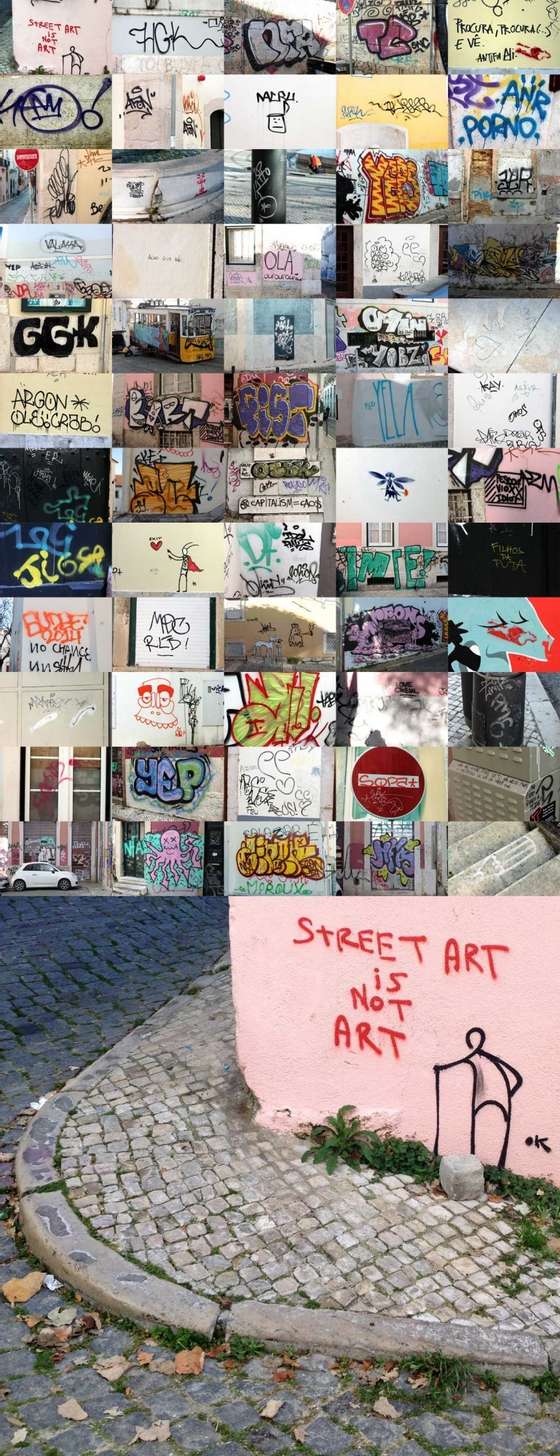Cresce como o bolor, sobe pelas paredes e pelos muros, deixando manchas pretas e feias. A única coisa que o impede de chegar mais acima é a altura média dos adolescentes da espécie humana.
Esta cidade dos séculos XVI, XVII, XVIII, XIX e XX, esta jóia barroca à beira Tejo, a cintilar sob a luz de um sol singularmente brilhante, que saltita entre o céu e o oceano Atlântico, está a ser comida vivo pelos graffiti.
As fotografias que aqui podem ser vistas foram tiradas em não mais do que um quarto de hora.
Ao nível mais baixo, os graffiti são representados pelo “tagging” nojento, feito por idiotas que rabiscam os seus nomes em qualquer superfície, independentemente de quão preciosa seja essa superfície, apenas porque lhes apetece e porque podem. De mistura com os nomes, aparecem as anedotas e ditos supostamente subversivos, os insultos racistas e as declarações de amor.
Também há, por tudo quanto é sítio, aquela coisa hedionda que são os nomes escritos em letras do tamanho de uma pessoa, redondas e cheias, altamente coloridas e brilhantes, e que, tal como a música de dança dos anos 90, nunca mudam: têm o mesmo aspecto que tinham em Nova Iorque nos anos 70 e não são mais interessantes do que qualquer coisa que uma miúda desenha no estojo dos lápis. São tão entediantes e subversivas como um pano molhado caído no chão. Há ainda os graffiti hipster, estranhos e surreais, e que ou são irónicos ou tão profundos que ninguém, além dos hipsters, os podem entender.
Anarquistas e comunistas sentem-se a vontade para pintar as suas banais chamadas às armas ou aos protestos porque acham que os muros não pertencem a ninguém (os anarquistas) ou pertencem a todos igualmente, mas mais igualmente a eles próprios (os comunistas). Pergunto-me quantas conversões às suas crenças eles obtiveram desta maneira. Nos dias da censura de Estado, podia-se desculpar os escritos nas paredes. Mas, hoje, temos a internet.
A cultura dos graffiti é uma cultura de “wise-assery”, de plágio e de repetição, tudo a fingir que é rebelião… rebelião sem muita causa, além da sujeira que ninguém consegue limpar.
Agora, temos de chamar aos graffiteiros “street artists”, senão eles põem-se a chorar lágrimas de tinta permanente. Pior ainda, graffiti de todas as espécies estão a ser encorajados vivamente… por nós. Nestes últimos anos, a “street art”, ou “arte urbana”, tem sido nobilitada por umas secções do mundo das artes e, mais estúpida e irritantemente, pelas câmaras municipais. É preciso dizer que todos foram ludibriados.
A maior parte da arte urbana permitida e promovida é tão feia como qualquer “tagging”. Não tem graça, nem espírito, nem imaginação, nem talento (um “aside”: existe um artista urbano de que gosto muito, não só porque é tecnicamente brilhante, mas também porque trabalha com/dentro/e através da matéria prima dos edifícios que desfigura/reconfigura. Ele é o Vhils, e é o único).
A aceitação súbita da arte urbana por pessoas normalmente de bom senso tem legitimado e encorajado toda a espécie de “artistas” de graffiti do mundo. Banksy, a pregar aos já-convertidos com os seus “stencils”, entrou nos corações de quase toda a gente e tornou aceitável o hábito de pintar banalidades com “stencils” em toda a parte.
Já ouvi o argumento de que a arte urbana autorizada ajuda a reduzir a quantidade de graffiti de baixo-nível perpetrados pelos idiotas. Bem, saia de casa e veja se reduziu. Melhor, vá ver uma peça de arte urbana autorizada e há-de reparar que está coberta de “tagging” e de tretas: nem a “arte urbana” escapa aos graffiteiros…
Também já ouvi o argumento de que os graffiti dão voz a toda a gente, especialmente aos mais pobres. É um argumento de treta. Sabem quanto custam essas latas de tinta?
A arte urbana é a roupa nova do imperador numa lata de tinta, executada em tamanho grande numa parede ainda maior. Quem tem menos de 65 anos, geralmente não se atreve a protestar contra “a arte urbana legítima”, com medo de que os seus amigos o achem um velho chato, e relutantemente diz que o Banksy tem interesse e que as tretas pintadas naquele prédio têm os seus méritos (quando sabe que não têm). Muitos dos artistas urbanos legitimados são artistas horríveis tecnicamente e também em termos de gosto, de criatividade e de respeito pelas cidades que lhes dão tela na forma de espaço. Nobilitar a sua arte é como nobilitar as tralhas que se encontram numa feira suburbana de artesanato, tralhas como aquelas coisas de malha na forma de uma boneca, com vestido grande, para cobrir rolos de papel higiénico.
Mas espere, pensando bem, talvez fosse preferível nobilitar aquelas coisas de malha na forma de uma boneca para cobrir os rolos de papel higiénico, porque ao menos eu poderia sair a meio da noite e pôr-lhes um fósforo. Desapareciam num instante. 
(traduzido do original inglês pela autora)
Lisbon looks like shit
It grows like mildew, creeping up the walls, leaving a thick black mess of ugly scrawls in its wake. The only thing that stops it climbing any higher is the average height of the human boy.
This beautiful 16th, 17th, 18th, 19th and 20th century city, this baroque jewel in the Tejo, gleaming in the uniquely bright sunlight that bounces between the sky and the Atlantic ocean, is being eaten alive by graffiti.
The photographs you see here were taken in the space of fifteen minutes.
At its lowest level, there is the repulsive “tagging”, done by morons, their names sprayed onto any surface they fancy, however precious that surface might be, just because they can, sprayed next to stupid jokes and supposedly subversive statements and racist insults and declarations of love.
Then there’s the ubiquitous, hideous, human height shiny bubble writing that, much like 90s dance music, mystifyingly never changes…it looks the same as it looked in New York in the seventies and is no more interesting than anything a twelve year old has scribbled on its pencil case, as boring and subversive as a damp rag. There is hipster graffiti in which something quirky and surreal is drawn on a wall, but it’s ok, because it’s either irony or so deep that no one but a hipster could understand it.
Anarchists and communists feel free to paint their banal calls to arms/protest because they think the walls belong to no one (the former) or belong equally to everyone, but more equally, of course, to them (the latter). I wonder how many conversions any of them have ever made, this side of state censorship. In days of state censorship, one can excuse political scribblings on a wall. These days, well, we have an internet.
It’s a culture of wise-assery and never-ending copying, masquerading as rebellion… rebellion without much of a cause except making a bloody mess that no one can clean up.
We now have to call them street artists, or they might burst into spray can tears. Worse still, graffiti of all kinds is being actively encouraged…. by us. In the last few years, “street art” has been gentrified by sections of the art world and more annoyingly and stupidly, by city councils. Everyone has been taken in by it.
Most sanctioned street art is just as ugly as any tagging, just as lacking in grace, wit, beauty, imagination and talent (an aside: there is only one well known street artist that I admire, not only because he is technically brilliant but because he works with and in and through the materials of the buildings he is defacing/refacing. That is Vhils, and he is the only one).
The sudden acceptance of street art by normally sane people is just legitimising and emboldening all the different kinds of graffiti artists out there in the world. Banksy, out there preaching to the choir with his anti-establishment stencillings, has been accepted into the hearts of almost everyone across the world and made it perfectly acceptable to go and spray stencilled banalities all over the place.
I have heard the argument that sanctioned street art helps to reduce the levels of the gratuitous, low-level graffiti of the idiot. Go outside your front door and tell me if that’s true. In fact, go and find your nearest piece of sanctioned “street art” and tell me that it isn’t covered with tags and rubbish.
I have heard the argument that graffiti allows everyone a voice, especially the poor and disenfranchised. It is a bullshit argument. Have you seen how much spray paint costs?
Street art is just Emperor’s new clothes in a spray can, writ large on an even larger wall. If you are under sixty five, you dare not rail against “legitimate street art”, lest your friends think you are square, so you begrudgingly say that Banksy is interesting and that rubbish painted on that enormous building has its merits (when you know it’s not and it hasn’t). The vast majority of the legitimised street artists are dreadful artists, technically, and in terms of taste and creativity and respect for the cities that give them free canvas. Gentrifying their art is like gentrifying the crap that makes up 90% of a suburban craft fair, like crocheted polyester loo roll covers in the shape of a doll in a big dress.
Actually, crocheted polyester loo roll covers in the shape of a doll in a big dress would be a better thing to gentrify, legitimise and sanction, because I could sneak out in the night and put a match to the whole damned lot. It would go up just like that.










